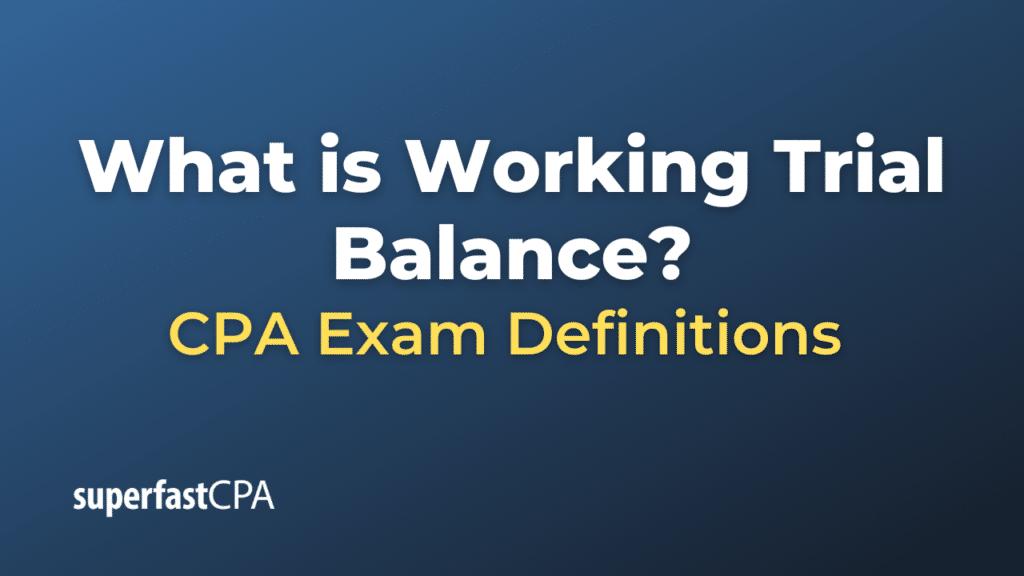Working Trial Balance
A Working Trial Balance is an extended version of the trial balance, which is used by accountants to facilitate the preparation of financial statements. The trial balance usually contains a list of all ledger accounts and their respective debit or credit balances at a specific point in time. A Working Trial Balance goes a step further by adding additional columns to allocate the balances of ledger accounts among different financial statements, like the income statement and the balance sheet.
Structure:
A typical Working Trial Balance may contain the following columns:
- Account Code or Number: To identify the specific ledger account.
- Account Name: Describes the nature of the account (e.g., Cash, Accounts Receivable, etc.).
- Debit Balance: Shows the debit balance of each account.
- Credit Balance: Shows the credit balance of each account.
- Adjusted Debit/Credit Balance: Reflects any adjustments made to the account balances.
- Income Statement Debit/Credit: Allocates the account balances that will go into the income statement.
- Balance Sheet Debit/Credit: Allocates the account balances that will go into the balance sheet.
Purpose:
- Financial Statement Preparation: The Working Trial Balance aids in the preparation of financial statements by showing where each account balance will appear.
- Error Detection: Helps in identifying discrepancies or errors in the ledger accounts.
- Account Reconciliation: Facilitates the reconciliation of accounts by showing the adjustments made to each account.
- Internal Review: Often used for internal review and analysis, especially during the year-end closing process.
Example of Working Trial Balance
Let’s delve into a fictional example to better understand the concept of a Working Trial Balance.
XYZ Corp is a small e-commerce company. At the end of the financial year, the company’s accountant prepares a Working Trial Balance as part of the year-end closing process.
Here’s a simplified Working Trial Balance for XYZ Corp:
| Account Code | Account Name | Debit Balance (USD) | Credit Balance (USD) | Adjusted Debit (USD) | Adjusted Credit (USD) | Income Stmt Debit (USD) | Balance Sheet Debit (USD) |
|---|---|---|---|---|---|---|---|
| 101 | Cash | 20,000 | 20,000 | 20,000 | |||
| 102 | Accounts Receivable | 10,000 | 10,000 | 10,000 | |||
| 201 | Sales Revenue | 50,000 | 50,000 | ||||
| 202 | Rent Expense | 8,000 | 8,000 | 8,000 | |||
| 203 | Utilities | 2,000 | 2,000 | 2,000 |
Key Highlights:
- Cash and Accounts Receivable: These are asset accounts with debit balances. In the Working Trial Balance, their adjusted debit balances are allocated to the Balance Sheet Debit column.
- Sales Revenue: This is an income account with a credit balance. Its adjusted credit balance is intended for the Income Statement but doesn’t appear explicitly in this table.
- Rent Expense and Utilities: These are expense accounts with debit balances. Their adjusted debit balances are allocated to the Income Statement Debit column.
- Adjusted Balances: In this example, we’ve assumed that there were no adjustments required. However, in a real-world scenario, this column would reflect adjustments for items like depreciation, accrued expenses, etc.
What Happens Next:
After preparing this Working Trial Balance, the accountant would proceed to draft the Income Statement and the Balance Sheet.
- Income Statement: The Rent Expense and Utilities totaling $10,000 would appear here.
- Balance Sheet: The Cash and Accounts Receivable totaling $30,000 would appear under assets.
By using the Working Trial Balance, the accountant can more easily allocate each ledger account to its respective place in the financial statements, making the process more efficient and accurate.













